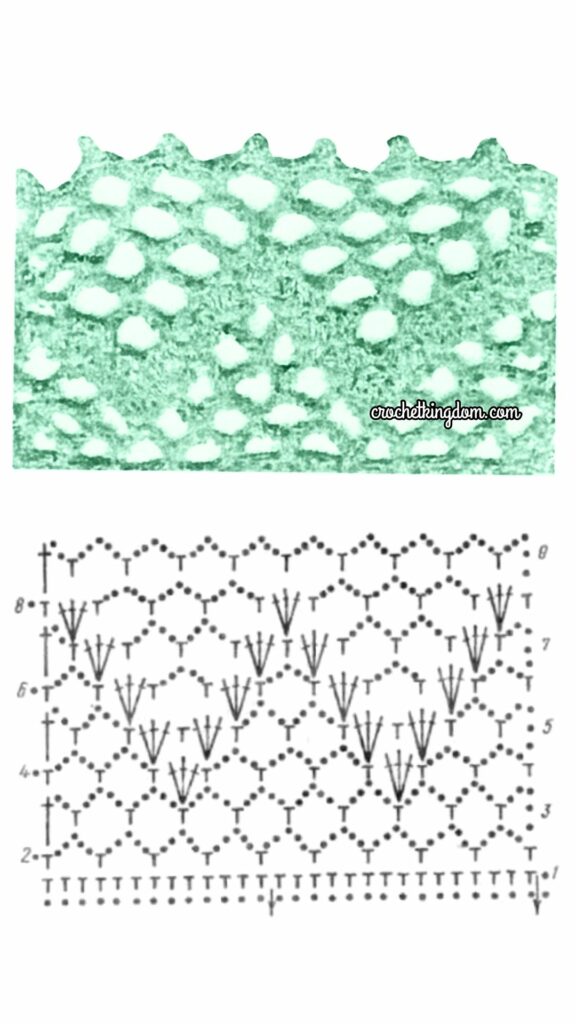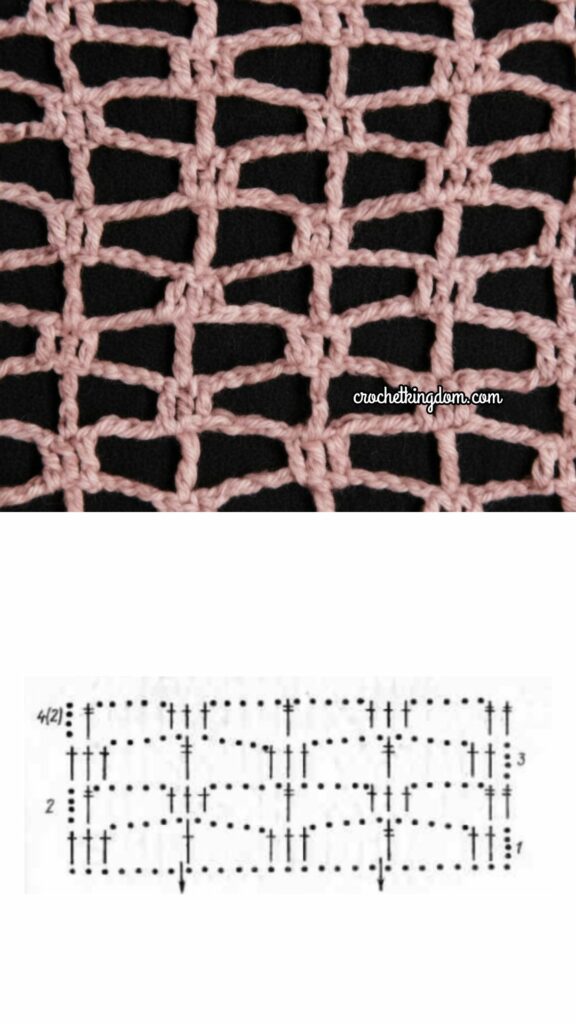Diagonal filet mesh is formed by chains of foundation chains anchored with single crochet stitches into stitches of the previous row or into the starting chain. The number of chains in each mesh segment can vary depending on the fabric density or the need to narrow or widen the piece, but most commonly it is 5.
The number of stitches in the starting chain is calculated according to the pattern repeat, the same way as for straight filet mesh. For example, for mesh segments made of 5 chains, make a starting chain with a number of stitches that is a multiple of 4, plus 5 chains for turning, and work as follows:
To increase or decrease mesh squares along the edge of the piece, work full squares (not half-squares) at the beginning and end of odd rows, the same as in even rows.
To evenly widen or narrow the fabric, increase or decrease the number of chains in each mesh square.
Diagonal filet mesh can be worked with empty or filled squares, and the squares and bars between them can take on many different configurations. The main feature of this mesh is that the squares are arranged in a staggered (checkerboard) order. Patterns with filled squares are widely used in lacework and lace shawls, outer knitwear and its accents, as well as home décor items.
Diagonal Crochet Mesh Stitch Sample 1
The number of stitches in the starting chain is calculated according to the pattern repeat, the same way as for a straight filet mesh. For example, for mesh chains made of 5 stitches, make a starting chain with a number of stitches that is a multiple of 4, plus 5 chains for turning, and work as follows:
Row 1:
Single crochet into the 3rd chain from the hook.
Chain 5, skip 3 chains, single crochet in the next chain, repeat to the end of the row.
Finish with chain 2, then double crochet into the last stitch of the chain.
Row 2:
Chain 5, single crochet into the 3rd chain of the previous row, repeat to the end.
Finish with a single crochet into the double crochet.
Continue following the chart (fig. 4.1).

Increase or Descreas Number of Squares
To increase or decrease the number of mesh squares along the edge of the piece, work full squares—not half squares—at the beginning and end of odd-numbered rows, the same way you do in even rows. For smooth shaping, widen or narrow the fabric by increasing or decreasing the number of chains in each mesh block.
Diagonal filet mesh can be worked with empty or filled squares, and the blocks and bars between them can take many different shapes. The main feature of this mesh is that its squares are arranged in a staggered (checkerboard) order. Patterns with filled squares are widely used for lacework, lace shawls, outer garments and accents, and home décor pieces.
Sample 2
Repeat: 6 stitches.
Work according to the chart

Diagonal Filet Mesh Crochet Tutorial Sample 2
Repeat: 6 stitches.
Work according to the chart

Diagonal Filet Mesh Crochet Tutorial Sample 3
Repeat: 24 stitches.
Work according to the chart

Diagonal Filet Mesh Crochet Tutorial Sample 4
Repeat: 15 stitches.
Work according to the chart

Diagonal Filet Mesh Crochet Tutorial Sample 6
Repeat: 12 stitches.
Work according to the chart
